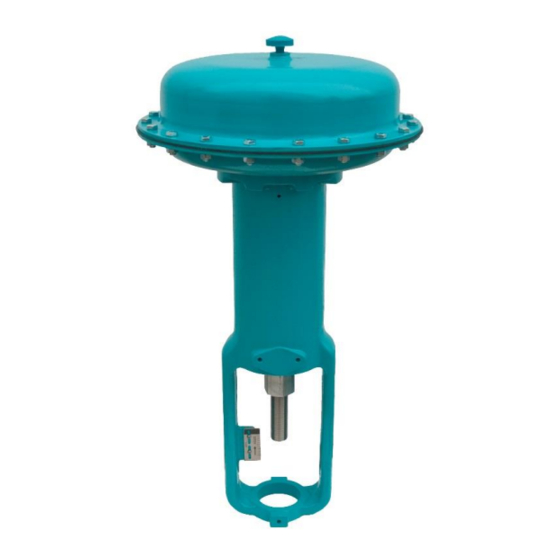- ページ 4
コントローラー CVS Controls 667のPDF 取扱説明書をオンラインで閲覧またはダウンロードできます。CVS Controls 667 8 ページ。 Diaphragm actuator

Spring Adjustments cont'd
3. To shift the span up, turn the spring adjustor
(Key 11) into the yoke. To shift the span down,
turn the spring adjustor out of the yoke.
For operation of the CVS 667 Diaphragm Actuator
the actuator stem and valve plug stem must move
freely in response to the loading pressure change on
the diaphragm.
Maintenance
Actuator parts are subject to normal wear and tear
and should be inspected regularly. The frequency of
inspection and replacement of parts is dependent on
the severity of operating conditions.
WARNING
A sudden release of pressure or any
uncontrolled process fluid can cause
personal injury or damage to property. Prior
to any disassembly, be sure to:
•
Isolate the valve from the process,
•
Release all process pressure
•
Vent the actuator loading pressure, and
•
Relieve all spring compression.
Disassembly
Although the following instructions describe how the
CVS Type 667 Diaphragm Actuator can be
completely disassembled, when inspection or repairs
are required, only disassemble those parts required
to accomplish the job. Key numbers refer to Figures
4 and 5.
1. Bypass the control valve and reduce the loading
pressure to atmospheric.
2. Remove the tubing or piping from the connection
in the top of the yoke (Key 9). For top-loaded
construction also remove the piping or tubing
from the connection in the upper diaphragm
casing (Key 7).
3. Thread the spring adjustor (Key 2) off the stem
(Key 3) to remove all spring compression.
4. If necessary remove the actuator from the valve
body by separating the stem connector (Key 21)
and removing the yoke locknut.
5. Remove the spring adjustor (Key 2) from the
actuator stem (Key 3) and lift the spring seat and
spring (Keys 4 and 1) out of the yoke.
6. Remove the diaphragm casing cap screws and
nuts (Keys 10 and 14) and lift off the upper
diaphragm casing (Key 7).
7. Remove the following parts: diaphragm (Key 6),
diaphragm plate (Key 5), spacer (Key 32), cap
screw (Key 11) and actuator stem (Key 3). Be
4
careful not to damage the O-rings (Key 25) when
pulling the threads of the actuator stem through
the seal bushing (Key 24). Remove the stem
through the housing of the yoke so as not to pull
the threads through the seal bushing.
8. Separate the parts of this assembly by removing
the cap screw (Key 11).
9. To remove the seal bushing, remove the snap
ring (Key 30) and lift out the bushing.
10. Remove the cap screws (Key 19), the lower
diaphragm casing (Key 8) and the gasket (sizes
30 through 60) or O-ring (size 70) (Key 28).
11. If necessary, the down travel stops can be
removed (Key 33).
Assembly
1. Place a new gasket or O-ring (Key 28) on the
yoke (Key 9) and apply lubricant to the O-ring.
2. Position the lower diaphragm casing (Key 8) on
the yoke, align the holes and insert and tighten
the cap screws (Key 19).
3. If the down travel stops (Key 33) were removed,
insert and tighten them.
4. Coat the O-rings (Keys 28 and 29) with lubricant
and place them in the seal bushing (24).
5. Fill the seal bushing with lubricant, slide the
bushing into the yoke (Key 9) and install the
snap ring (Key 30).
6. Insert the actuator stem (Key 3) through the
spring housing of the yoke, then add the lower
diaphragm plate (Key 29), diaphragm (Key 6),
diaphragm plate (Key 5), and the travel stop cap
screw and spacer (Keys 11 and 32).
7. Place this assembly in the actuator, being careful
when pushing the actuator stem through the seal
bushing that the threads do not damage the O-
rings.
Note: Over tightening the diaphragm cap
screws and nuts can damage the diaphragm.
Do not exceed 20 foot-pounds (27 Newton
meters) torque.
8. Install the upper diaphragm casing (Key 7) and
secure with cap screws and nuts (Keys 10 and
14). Tighten evenly using a crisscross pattern to
ensure a proper seal.
9. Install the actuator spring (Key 1) and spring
seat (Key 4). Apply lubricant to the threads of
the actuator stem and to the surface of the
spring adjustor (Key 2) that contacts the spring
seat. Thread the spring adjustor onto the
actuator stem.
10. Mount the actuator onto the valve, following
procedures in the "Installation" section of this
manual.
